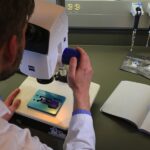 A multi-disciplinary team at Oregon State University is using nanoparticles of iron oxide to help detect chemical and biological agents, proving again Neil Young’s truism that rust never sleeps.
A multi-disciplinary team at Oregon State University is using nanoparticles of iron oxide to help detect chemical and biological agents, proving again Neil Young’s truism that rust never sleeps. A multi-disciplinary team at Oregon State University is using nanoparticles of iron oxide to help detect chemical and biological agents, proving again Neil Young’s truism that rust never sleeps. Existing methods for identifying chemicals are often time-consuming, and require expensive equipment and trained experts. So Pallavi Dhagat, a professor of computer science and electrical engineering, and Vincent Remcho, a professor of chemistry, assembled a cheap and efficient alternative: a tiny, all-in-one diagnostic laboratory in which the rust nanoparticles perform double duty. The iron oxide helps ferret out the chemical in question, then instantly relays the information, via magnetism and electronics, to a tiny computer, which in turn displays the results to the user. Funded by the U.S. Army Research Laboratory, in collaboration with the Oregon Nanoscience and Microtechnologies Institute, the magnetic “nanobeads” project began four years ago as a technology to locate bioterrorism toxins. But the system, which Remcho extols for its “sensitivity and specificity,” can also be used in any number of civilian applications, including medical diagnostics, environmental monitoring, and food and water safety. “It’s an amazingly flexible detection platform,” says Remcho, whose team is currently “miniaturizing ancillary components.” No rest for the rusty.
A multi-disciplinary team at Oregon State University is using nanoparticles of iron oxide to help detect chemical and biological agents, proving again Neil Young’s truism that rust never sleeps. Existing methods for identifying chemicals are often time-consuming, and require expensive equipment and trained experts. So Pallavi Dhagat, a professor of computer science and electrical engineering, and Vincent Remcho, a professor of chemistry, assembled a cheap and efficient alternative: a tiny, all-in-one diagnostic laboratory in which the rust nanoparticles perform double duty. The iron oxide helps ferret out the chemical in question, then instantly relays the information, via magnetism and electronics, to a tiny computer, which in turn displays the results to the user. Funded by the U.S. Army Research Laboratory, in collaboration with the Oregon Nanoscience and Microtechnologies Institute, the magnetic “nanobeads” project began four years ago as a technology to locate bioterrorism toxins. But the system, which Remcho extols for its “sensitivity and specificity,” can also be used in any number of civilian applications, including medical diagnostics, environmental monitoring, and food and water safety. “It’s an amazingly flexible detection platform,” says Remcho, whose team is currently “miniaturizing ancillary components.” No rest for the rusty.
LINDA BAKER


